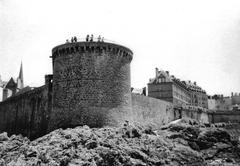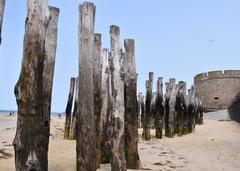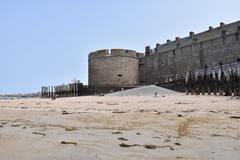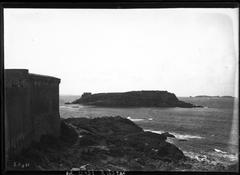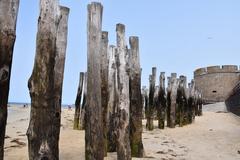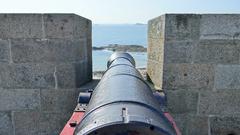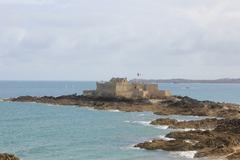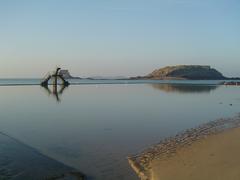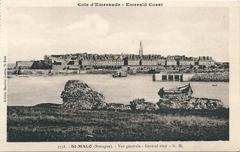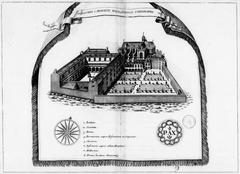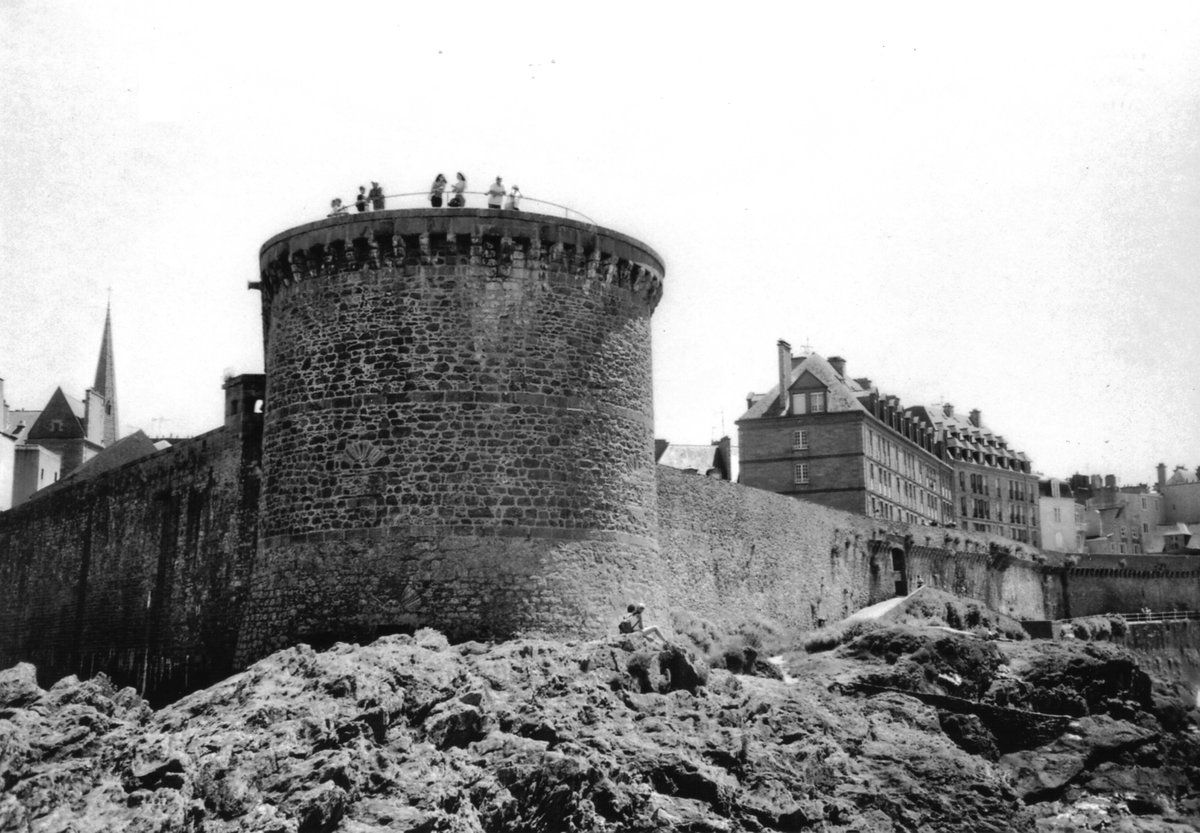
Tour Bidouane Visiting Hours, Tickets, and Travel Guide in Saint-Malo, France
Date: 14/06/2025
Introduction to Tour Bidouane
Tour Bidouane, perched on the historic ramparts of Saint-Malo, France, is an enduring symbol of the city’s maritime might and turbulent past. This formidable 15th-century horseshoe-shaped artillery tower, later transformed into a powder magazine, offers panoramic coastal views, rich stories of corsair exploits, and a living testament to centuries of military innovation. Integrated into the UNESCO-listed city walls, Tour Bidouane stands not only as a monument to defense, but also as a vibrant cultural landmark. This guide provides everything you need to know about visiting Tour Bidouane: history, architecture, visiting hours, tickets, accessibility, nearby attractions, and practical tips for making the most of your journey to Brittany’s Emerald Coast (Nomads Travel Guide, Regard de Corsaire, Carnets Vanille).
Table of Contents
- Introduction to Tour Bidouane
- Historical Overview
- Architectural Features
- Visiting Information
- Nearby Attractions
- Events, Culture, & Photography
- Frequently Asked Questions (FAQ)
- Conclusion & Visitor Recommendations
- Official Sources & Further Reading
Historical Overview
Origins & Early Construction
Tour Bidouane was built in the late 15th century during a period of major advancements in military architecture. Positioned at the northwest corner of Saint-Malo’s fortified Intra-Muros, the tower’s horseshoe (“fer à cheval”) design and thick granite walls were specifically engineered to withstand artillery and maximize defensive firepower (Nomads Travel Guide, Navaway). Its strategic location enabled control of the harbor entrance and rapid response to attacks from sea or land.
Military Evolution & Role
Tour Bidouane has been central to Saint-Malo’s defense for over five centuries. In the 17th century, as threats increased, the city’s fortifications were modernized under the guidance of engineers like Vauban and Garangeau. The tower was expanded and, by 1691, repurposed as a powder magazine—its robust granite construction making it an ideal storage site for explosives (Travel France Online, Nomads Travel Guide).
Tour Bidouane’s defensive prowess was famously tested in 1693 during the Nine Years’ War, when Anglo-Dutch forces attempted to breach the ramparts using a floating bomb. The tower’s structure survived the blast, and Saint-Malo’s defenses held firm (Navaway). In the centuries that followed, the tower remained integral to the city’s security, including its fortification by German forces during World War II as part of the Atlantic Wall (WWII Then and Now).
Restoration & Modern Use
After being demilitarized in 1889, Tour Bidouane was restored and integrated into Saint-Malo’s ramparts for public enjoyment. Meticulous post-World War II restoration preserved its 18th-century character, allowing visitors today to experience its original grandeur (WWII Then and Now). The tower now serves as a cultural venue and a highlight of the city’s rampart walk.
Architectural Features
Structure & Materials
Tour Bidouane stands approximately 23 meters tall and 13 meters in diameter, with granite walls up to 3 meters thick (Regard de Corsaire, lieux-insolites.fr). The horseshoe plan allowed defenders to target multiple approaches while deflecting incoming artillery fire (petitfute.com).
Defensive Elements
The upper platform once housed five iron cannons, and the lower levels functioned as bombproof powder magazines (Regard de Corsaire). Embrasures and loopholes enabled defenders to fire under cover, while narrow staircases limited enemy movement if breached.
Interior Spaces
The tower is divided across three main levels:
- Ground Floor: Vaulted powder magazine.
- Upper Levels: Troop quarters and munitions storage.
- Terrace: Today, an orientation table helps visitors identify coastal landmarks such as Grand Bé, Cap Fréhel, and Chateaubriand’s tomb (Regard de Corsaire, francerent.com).
Decorative elements include carved stonework at the entrance and the historical bell “Noguette,” which signaled curfew—a tradition commemorated today by the cathedral’s bell (petitfute.com).
Visiting Information
Hours & Tickets
- Hours: High season (April–October), 9:30 AM–6:30 PM. Reduced hours in the low season.
- Tickets: General access to the ramparts and tower exterior is free. Interior access (during exhibitions or guided tours) may require a nominal ticket, bookable on-site or online via the official tourism website.
Accessibility
Access to the ramparts is pedestrian-friendly, though entry to the tower’s interior involves stone steps and narrow staircases, limiting access for wheelchair users or those with reduced mobility. The upper terrace can sometimes be reached with assistance, but some interior areas remain inaccessible.
Practical Tips
- Best Time to Visit: Early morning or late afternoon for ideal light and fewer crowds.
- Weather: Coastal winds are common; bring suitable clothing and non-slip shoes.
- Facilities: No restrooms or refreshments inside, but Intra-Muros offers ample amenities.
- Photography: Panoramic views of the city and sea are best at sunrise or sunset.
- Pets: Dogs on leashes are allowed on the ramparts, but not inside the tower.
Nearby Attractions
Enhance your visit by exploring these Saint-Malo historical sites:
- Saint-Malo Cathedral: Gothic and Romanesque architecture within a short walk.
- Fort National: 17th-century sea fort accessible at low tide.
- Grand Bé: Tidal island, burial place of Chateaubriand.
- Bon Secours Beach: Sandy beach beneath the ramparts.
- Maison du Québec: Celebrating Saint-Malo’s transatlantic ties.
Events, Culture, & Photography
Tour Bidouane hosts art exhibitions, concerts, and is a venue for the “La Route du Rock” festival (La Route du Rock). It is also a backdrop for citywide events like maritime festivals and historical reenactments (France Voyage Events). Its terrace is a favorite for photographers, offering sweeping views of the Emerald Coast.
Frequently Asked Questions (FAQ)
Q: What are Tour Bidouane’s visiting hours?
A: Typically 9:30 AM–6:30 PM in high season. Always check the official website for current hours.
Q: Is there an entrance fee?
A: Ramparts and tower exterior are free. Guided tours or exhibitions inside the tower may require a ticket.
Q: Is Tour Bidouane wheelchair accessible?
A: Ramparts are generally accessible; the tower interior is not, due to historic staircases.
Q: Are guided tours available?
A: Yes, especially during the peak season and special events (Saint-Malo tourism office).
Q: Can I bring my dog?
A: Dogs on leashes are allowed on the ramparts; restrictions may apply inside the tower.
Conclusion & Visitor Recommendations
Tour Bidouane is the epitome of Saint-Malo’s resilience, maritime tradition, and architectural brilliance. Whether you’re immersing yourself in military history, attending a festival, or simply admiring the city’s panoramic vistas, the tower is a must-visit highlight. Maximize your experience by walking the full ramparts circuit, joining a guided tour, and exploring nearby historical gems. For up-to-date schedules, event listings, and exclusive digital tours, visit the Saint-Malo tourism website and download the Audiala app. Follow us on social media for the latest news, tips, and travel inspiration.
Visual Media Suggestions
Alt: Panoramic view from Tour Bidouane of the English Channel and Saint-Malo coastline Alt: Granite masonry of Tour Bidouane’s ramparts
- Historical and interactive maps are available on the official tourism portal.
Official Sources and Further Reading
- Tour Bidouane: Visiting Hours, Tickets, and History (Nomads Travel Guide)
- Tour Bidouane in Saint-Malo: Visiting Hours, History, and Travel Tips (Regard de Corsaire)
- Things to Do in St-Malo (Carnets Vanille)
- Visiting Hours & Guide to Saint-Malo Historical Sites (Nomads Travel Guide)
- Saint-Malo Official Tourism Website
- WWII Then and Now: Saint-Malo
- La Route du Rock Festival Venue
